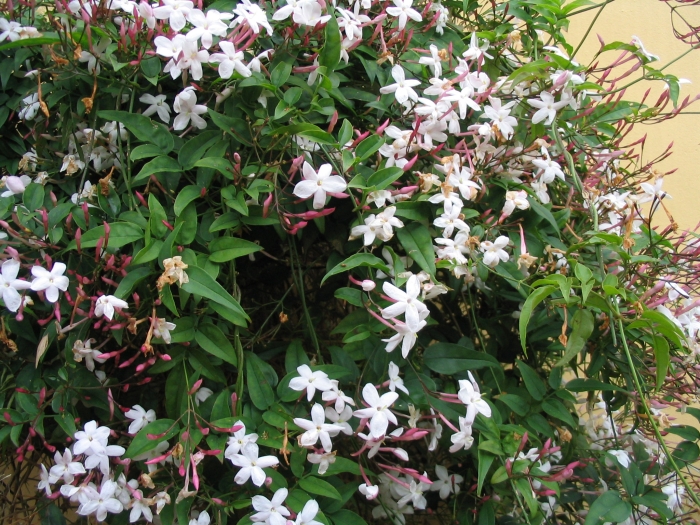Pink Jasmine
(Jasminum polyanthum)
Pink Jasmine (Jasminum polyanthum)
/
/

HelenOnline
CC BY-SA 3.0
Image By:
HelenOnline
Recorded By:
Copyright:
CC BY-SA 3.0
Copyright Notice:
Photo by: HelenOnline | License Type: CC BY-SA 3.0 | License URL: https://creativecommons.org/licenses/by-sa/3.0 | Uploader: HelenOnline | Publisher: Wikimedia Commons | Title: Chinese_jasmine_in_spring_bloom.JPG | Notes: {{Information |Description={{en|1=Bellyache Bush or Cottonleaf Physic Nut ''[[Jatropha gossipifolia]]'' in [[Hyderabad]] , [[India]].}} |Source=Own work by uploader |Author=[[User:J.M.Garg|J.M.Garg]] |Date=13/9/08 |Permission= |other_versions= }} [[Categ













































































Estimated Native Range
Summary
Jasminum polyanthum, commonly known as Pink Jasmine, is an evergreen vine native to open woodlands and forest edges in China and Myanmar. It is a vigorous climber that can reach up to 6 meters in height when supported. The plant features compound leaves with 5 to 9 leaflets that are dark green on the upper surface and lighter green beneath. Its branches are glabrous, terete, or angular, with the terminal leaflet being noticeably larger than the others. Pink Jasmine is celebrated for its profuse, highly fragrant flowers that appear in late winter to early spring. The reddish-pink buds open to reveal starry white, five-petalled flowers, about 2 cm in diameter, which are particularly showy and emit a strong, sweet fragrance. Following the flowering season, it produces a black, globular berry.
Pink Jasmine is valued for its rapid growth, ease of maintenance, and the delightful scent of its flowers. It is commonly used as a houseplant and can also be grown outdoors in suitable climates to cover walls, fences, and trellises, adding a romantic touch to gardens. It thrives in full sun to light shade and prefers soils with medium drainage, requiring low to medium amounts of water. While it is easy to propagate by seed and suckers, gardeners should be cautious as Jasminum polyanthum can become invasive outside its native range. It is hardy in USDA zones 8 to 11 and cannot tolerate freezing temperatures.CC BY-SA 4.0
Pink Jasmine is valued for its rapid growth, ease of maintenance, and the delightful scent of its flowers. It is commonly used as a houseplant and can also be grown outdoors in suitable climates to cover walls, fences, and trellises, adding a romantic touch to gardens. It thrives in full sun to light shade and prefers soils with medium drainage, requiring low to medium amounts of water. While it is easy to propagate by seed and suckers, gardeners should be cautious as Jasminum polyanthum can become invasive outside its native range. It is hardy in USDA zones 8 to 11 and cannot tolerate freezing temperatures.CC BY-SA 4.0
Plant Description
- Plant Type: Vine
- Height: 8-20 feet
- Width: 3-5 feet
- Growth Rate: Rapid
- Flower Color: Pink, White
- Flowering Season: Winter, Spring
- Leaf Retention: Evergreen
Growth Requirements
- Sun: Full Sun, Part Shade
- Water: Medium
- Drainage: Medium
Common Uses
Bee Garden, Bird Garden, Border Plant, Butterfly Garden, Deer Resistant, Drought Tolerant, Fragrant, Hummingbird Garden, Low Maintenance, Showy Flowers, Street Planting
Natural Habitat
Open woodlands and forest edges
Other Names
Common Names: Many-Flowered Jasmine, Vippjasmin, Duo Hua Su Xin
Scientific Names: , Jasminum polyanthum, Jasminum blinii, Jasminum delafieldii, Jasminum excellens,
GBIF Accepted Name: Jasminum polyanthum Franch.